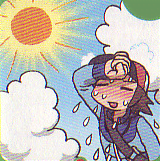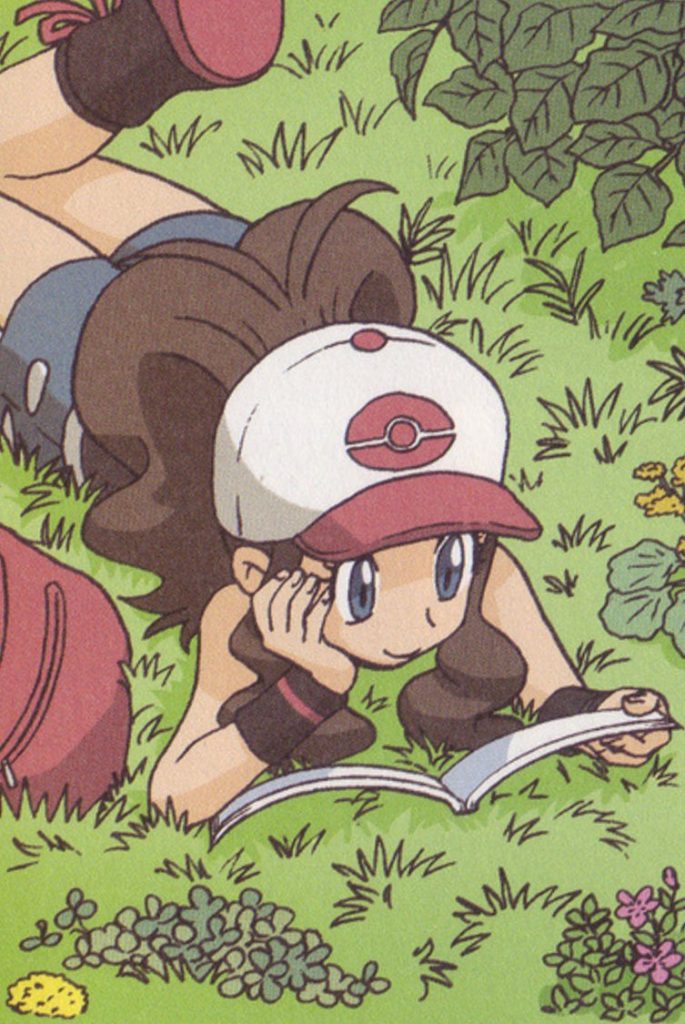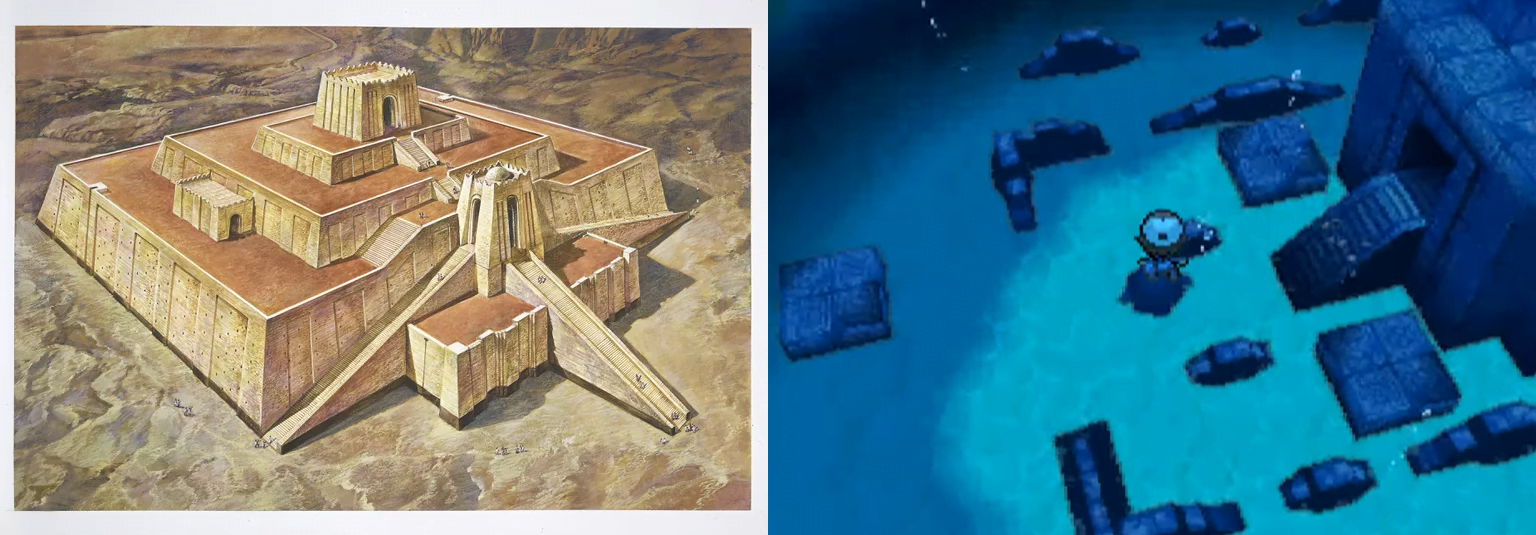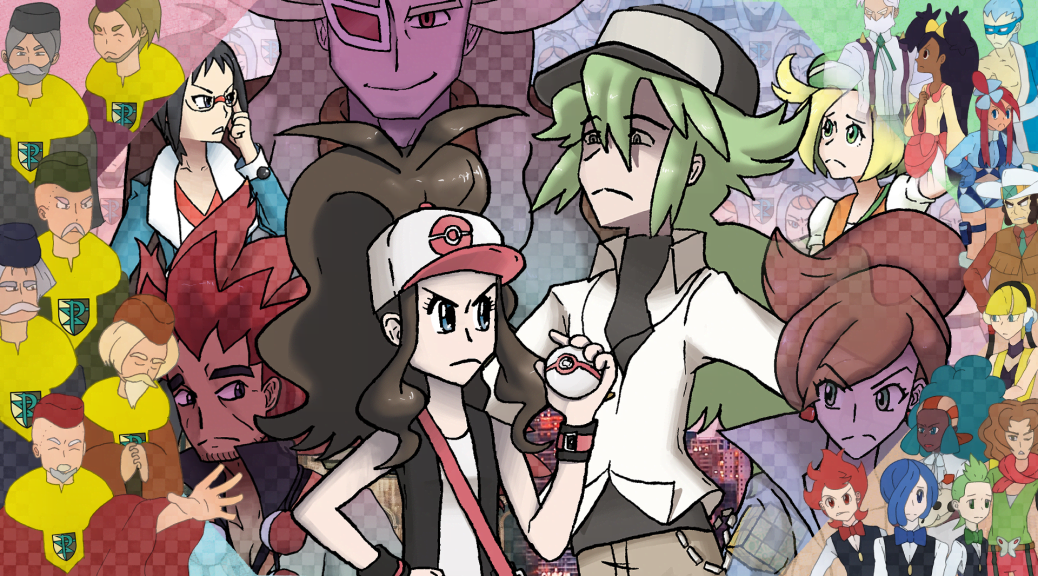Part II: The Chapters of Unova
For the anniversary of the release of Pokémon Black and White, we continue our tribute to the games. Part II focuses on the main storyline and its synthesis of narrative and gameplay.

Part II: The Chapters of Unova
Beginnings | Foundations | Castelia | Nimbasa | Driftveil | Chargestone | Icirrus
Dragonspiral | Reshiram & Zekrom | Relic Castle | The Stone | Opelucid | The League | N’s Bridge | The Sages
N’s Room | The End | Beginnings (Redux) | Kyurem | The Ruins | The End (Redux) | Champions
History Runs Deep
 During the spring, fall, and winter, the beachfront Undella Town’s music is calming, with gently crashing waves that make up the piece as much as the subdued instrumentals. During the summer, the place comes to life with an energetic tropical beat, and more NPCs come to visit as well. But any season is a good time to take a swim eastward in the bay, where some patches of darker water indicate something deeper below. You can obtain the HM for Dive nearby, allowing you to descend into the depths. If you don’t continue your descent, you’ll naturally float back up and out of the water. But this clever detail may be lost on most, as players are immediately greeted with the striking imagery of a sunken temple.
During the spring, fall, and winter, the beachfront Undella Town’s music is calming, with gently crashing waves that make up the piece as much as the subdued instrumentals. During the summer, the place comes to life with an energetic tropical beat, and more NPCs come to visit as well. But any season is a good time to take a swim eastward in the bay, where some patches of darker water indicate something deeper below. You can obtain the HM for Dive nearby, allowing you to descend into the depths. If you don’t continue your descent, you’ll naturally float back up and out of the water. But this clever detail may be lost on most, as players are immediately greeted with the striking imagery of a sunken temple.
In addition to the intriguing sight before them enticing players forward, diving beneath the bay instigates a music change heard nowhere else. A haunting melody twinkles and echoes, befitting an underwater realm, while string instruments play in a unique key, appropriate for the place’s ancientness. Upon entering one of the interconnected temples, a clicking sound can be heard. As you explore, a dull sound follows, growing louder and shaking the ruins as it gets closer. Eventually, after taking enough steps, a torrent of water catches up to you and washes you out of the ruins, returning you to the closest exit.
While there’s plenty of time to look around, it’s impossible to comb the entire labyrinth in one go. The first floor is an enormous maze littered with special items—some are “relic” items, treasures with no use but can be sold to a collector for a high price. Others are “plates,” more practical items that, when held, power up a certain type of attack, although by less than other type-based held items such as the TwistedSpoon or Soft Sand. Since these plates only appear in these ruins, players can tell they’re inherently ancient. Those familiar with Sinnoh lore, however, will certainly wonder how these plates, related to the Alpha Pokémon Arceus, have found their way beneath these ancient waves.
If you want to push further into the ruins—perhaps after picking up each item on separate visits—be prepared to decipher an ancient language. Every so often a pillar will be colored bright magenta, donning a plaque with some type of writing. Inspecting these pillars will display a unique rune-like alphabet in a distinct, scroll-shaped text box. Although seemingly based on the real-world cuneiform, these letters are exclusive to the Pokémon world, and therefore must be deciphered by the players themselves.
Unlike past sidequests in games such as Ruby, Sapphire, and Emerald, which utilized a real-world system for their glyphs—in the case of the Hoenn-set games, braille—the writing in the Abyssal Ruins is entirely made-up for the games. It’s not a simple matter of figuring out what the writing system is and then using a guide to translate what lies before you, but rather requires working out what the letters themselves even are before you can begin cracking the cipher to bring it all together.
 And there’s no official source to help with deciphering the Abyssal Ruins’ glyphs, either. The games’ official guidebook only includes a map of the first—of four!—floors, and is frustratingly vague about its messages. “Mysterious letters are carved in the stones,” the guide reads. “These letters have not been deciphered. What could be written here?”1 I was actually hoping you could at least give me a hint, considering what a “guide” is supposed to do!
And there’s no official source to help with deciphering the Abyssal Ruins’ glyphs, either. The games’ official guidebook only includes a map of the first—of four!—floors, and is frustratingly vague about its messages. “Mysterious letters are carved in the stones,” the guide reads. “These letters have not been deciphered. What could be written here?”1 I was actually hoping you could at least give me a hint, considering what a “guide” is supposed to do!
Fortunately, the most practical rewards in these ruins are the holdable plate items. Everything else is either sold for money, therefore being nonessential, or fascinating lore regarding ancient Unova. People without the patience to crack the code themselves—or wait for someone else to figure it out—could still easily grab the most relevant items in a few trips to the first floor, then continue on their way. If something far more “worthwhile” had been waiting at the ruins’ end, the language would need to be less ambiguous to make it more reasonable for players to get through. It would have been frustrating, and hardly a “fair challenge,” to lock something more valuable such as a legendary Pokémon here—and Unova already has plenty in better locations. Instead, players can expect thought-provoking pieces of Unovan lore as well as the timeless video game reward of bragging rights for obtaining what is possibly the rarest item in the game, even if said item serves no purpose in battle. This results in an area that is entirely fair through being entirely optional.
Yet people love a good mystery, perhaps almost as much as bragging rights. Uncovering the secrets of these ruins became a massive collaborative effort as players seeking answers converged on online discussion boards. They made their own maps with optimized paths to the highest floor and combed through the first floor’s messages for repeating symbols to try and work out a cipher. Whether intentional or not, the process of uncovering the Abyssal Ruins’ mysteries effectively required numerous different people to unite and, through working together, come up with a solution—perfectly befitting Black and White.

Thanks to the hard work of dedicated fans, the first floor’s messages were soon interpreted, and they began to tell a story:
| Listen to King’s words | Primes lead to truth | King is brave | King never loses hope |
| King is kind | King has a dream | King is adventurous | King accepts all |
| King turns 2nd corner | King turns 3rd corner | King turns 5th corner | King turns 7th corner |
| Have the heart of King | Here we praise King | King’s light shines | King moves his people |
| King acts with love | King fought hatred |
These plaques, while referring to the ancient Unovan king, seem to describe traits of someone you already know. You can’t help but imagine a certain modern-day king when reading characteristics such as brave, adventurous, kind-hearted, interest in prime numbers—of which two, three, five, and seven are the first—and having a dream. And while the referenced corners aren’t applicable to the winding path you must take through the maze, “King’s light shines” and “King moves his people” serve both to describe this ancient king’s influence as well as to hint at upcoming necessities for progressing to the top of the ruins. But for now, a colored column at the very center of the floor bars your way upward. If you reach this message after too many steps, it will show writing that translates to “No king gets lost.” You must find your way to this column in less than 190 steps for the message to instead read, “Go on, brave king.” While you may not be the king himself, throughout the game you have earned being considered his equal.
As the column moves aside, the reference to you as a king now moving forward with the ancient ruler similarly reminds you of how ancient Unova housed twin heroes, a legend brought into the present day. As you ascend, the next floor includes less copper and more interesting items, including statues, vases, and bangles. The messages on the second floor shift, too, and in more ways than one. The cipher itself changes, requiring you to offset the associated letters by one. And the content changes from discussing the ancient king to describing the ethics of the land’s people:
| Life is gratitude | Eating is receiving life | Good or evil isn’t all |
| Do not be barbaric | One must not waste | All is precious |
| Wars create tears |
These messages paint a clearer picture of the peaceful, grateful beliefs of the ancient Unovan civilization. “Good or evil isn’t all” also continues to push the belief of how things aren’t always simply black or white.
If you can avoid being whisked out of the ruins, you’ll find the westernmost colored column reading: “Shine if agreed.” If you caught on to the earlier hint with “King’s light shines,” you may consider using the field move Flash here, considering its direct association with light and typical ability to be used outside of battle. Doing so causes the pillar to rumble and move away, allowing you to continue.
The third floor lacks any copper at all, instead housing the more valuable antiques. Again the cipher shifts and the messages return to discussing the king:
| King talks to all beings | Saved all from waves |
| King is hope for all | Think, act with love |
A king who can speak “to all beings” and who thinks and acts “with love” once again draws parallels to the king you already know. Although these ruins have sunk into the ocean, it would appear the past king once saved the civilization from this very fate, instilling in the people a sense of hope.
The goal on this floor is to find the rightmost column which reads, “Act strong if agreed.” Again, the way to move this pillar is hinted at on the first floor. “King moves his people” is both figurative and literal, as this is the place to use the HM associated with strength and moving objects, Strength itself. The column once again slides aside to let you through, and you may proceed.
The fourth and final floor is no longer maze-like but is instead entirely open. At the center of the room is a singular Relic Crown, which is worth 300,000 Poké Dollars when sold to the billionaire in Undella Town. If you made it here with steps to spare, you can see that surrounding the crown are more colored pillars, but even using the shifting cipher, they can’t be entirely decoded. Four of the five pillars have their own logograms, characters that represent an entire word, that are found nowhere else. Within the confines of Black and White, it’s impossible to know exactly what they represent. The most that can be translated of these columns is as follows:
| King defeated [???] alone | King called [???] beings | |
| [???] joined King in a day | King is hope and future | |
| The great King [???] |
It won’t be long before the torrent of water is upon you, snatching you back up to the surface. In your possession now is the crown of the great king of ancient Unova, who both saved his people from what seems to be a great flood in addition to defeating a mysterious threat. You also caught a glimpse at the peaceful way of life of the ancient people. The coins of copper, silver, and gold were likely their form of currency, and they made pottery, statues, and even their own jewelry, all left behind in this temple for their beloved king.
The attention to detail of these ancient people and their king may not have been entirely necessary to include in the games, but it’s an appreciated detail all the same. With such emphasis placed on reviving the ancient lore of Unova to capture the hearts of the modern citizens, such optional additional information shows a great care for lore consistency, and, as with most narrative elements of Black and White, continue to provide solid, relevant themeing.
The use of the word “relic” is consistent with that of the Relic Castle within the sands. In Japanese, they both use the term kodai, an adjectival noun meaning “ancient times.” Right away a strict contrast is established, the castle sunken into the desert sands while the temple ruins sank deep beneath the waters of Undella Bay—yet both are subjected to the unrelenting passage of time. In addition, the aforementioned primary instruments and key of the Abyssal Ruins’ background music sounds quite fitting for a desert-themed level despite being underwater, creating even further connection. This is quite sensible, in fact, as the temple must have originally been located in a sandy area, considering it’s now engulfed by the bay and one of the columns details that the king “saved all from waves,” likely a tsunami or other tidal wave.
The Relic Castle is described by Professor Juniper to have thrived 2,500 years ago, and the ancient orbs containing Reshiram and Zekrom are from the same area. Additionally, the Dragonspiral Tower is noted by the Junipers to be from the same era—but the relic items you now possess date back 3,000 years. Admittedly, trying to piece together the entire timeline of the ancient Unovan civilization can be a bit tricky. Without established dates for major events such as the first battle of the twin heroes, or the destruction of Unova when their descendants clashed, it’s unclear whether the gap between the relic items and the Relic Castle’s peak is due to these events or not. But it’s still fun to let the theory machine run. It seems likely that the undecipherable character who “joined King in a day” may have been the original dragon of Unovan myth, Reshiram and Zekrom’s complete, combined, “perfect” form. If the king’s brother entered the picture later, and the unnamed dragon split as a result, that would make this king the original hero of Unova.
It’s therefore unclear how the orbs made their way to the Relic Castle. Was this temple originally built at the outskirts of the civilization and the orbs moved? Or was it built at the center and the center itself moved as capitols tend to do, taking the orbs with it? Did the battle between Reshiram and Zekrom that destroyed the region happen at the temple, 3,000 years ago, or at the castle, 2,500 years ago? We can’t really know for sure, but there are still similarities between the temple and castle that establish consistency between their 500-year gap. A subtle but clever detail is how there are vases found within both the temple and in Volcarona’s room in the castle. Pottery is a common object placed in ancient tombs, and both Volcarona and the ancient king were likely seen as gods—Volcarona for serving as the sun, and the king not only due to his station, but for his supposed ability to speak to all beings. And while the most revered king was buried 500 years prior in the now-sunken temple, the Relic Castle, being a castle, likely housed another king—perhaps a descendant. As such, the repeated use of vases as gifts or offerings to those considered sacred is a clever detail in spite of its irrelevance on any sort of plot.
What’s instead directly relevant is the ancient Unovan writing system, which has visual similarities to cuneiform. This ancient writing system was used in various civilizations, including Mesopotamia, whose sacred temples, the ziggurats, were stepped, “forming a symbolic sacred mountain.”2 We’ve already seen more blatant “sacred mountain” imagery with the Pokémon League’s Elite Four’s castle and Champion’s temple atop the highest peak of the region. This allows the Abyssal Ruins to further enforce the way the culture of ancient Unova has shaped its modern day even though so much of it is shrouded in mystery, not unlike how people may be influenced by ancient architecture styles without fully understanding their origins. Additionally, what little players can see of the submerged ruins bears striking resemblance to the exterior structure of a ziggurat, making the comparison even more apt.

The ancient Unovan writing system is also reminiscent of Egyptian hieroglyphics, a writing system which similarly included letters and logograms simultaneously. The parallels to ancient Egyptian culture should be quite obvious with association to the desert and a sun god through the Relic Castle and Volcarona. The way the Abyssal Ruins’ floors get smaller as you ascend may also remind one of the tapering structure of the ancient pyramids, built to represent the immortality of their pharaohs.3 Considering Pokémon such as Yamask and Cofagrigus indicate the ancient Unovans had burial traditions similar to the ancient Egyptians, it’s safe to say their king was buried similarly—to say nothing of the ancient mythos being both recited and recreated in the present, making the ancient king figuratively immortal.
Yet the most interesting connection the Abyssal Ruins has with the “real-world” is its ties to the story of the sunken city of Atlantis. Atlantis was considered a paradise—a perfect place filled with perfect people living in harmony with nature under the rule of wise kings.4 This already aligns almost one-for-one with the history of ancient Unova, with their intelligent king and harmonious lifestyle. But unfortunately for Atlantis, the people grew corrupt, and the gods submerged it.5 Although slightly deviated, the idea still aligns with Unovan myth: eventually the kings’ heirs quarreled using the might of their god-like Pokémon and razed their entire region.
But this parallel is more than just a basis for the region’s backstory—it also serves to further tie Unova’s themes together while linking its past and present. The story of Atlantis was penned by none other than the philosopher Plato.6 The very same philosopher whose allegory of the cave forms the basis for N’s mindset also provides the framework for the oldest iteration of Unovan civilization, complete with a king to match N. And as if that wasn’t enough, according to Plato the story of Atlantis had come from Solon, his ancestor from Egypt.7 This further ties the dichotomy of sands and seas with the connection between Egypt and Atlantis. The Desert Resort and the Abyssal Ruins: two locations distant in both space and time, but intrinsically connected. Unova continues to emphasize how the past is always with us and inadvertently shapes us through its long-running and present-defining lore, while also stressing how we can learn, grow, and improve from our pasts. Just as those hearing the story of the sunken Atlantis would want to avoid making the same mistakes and meet untimely ruin, the player and N learn to control their Pokémon and are able to recreate the climactic battle of truth and ideals without bringing about an end to the region in the same way as the kings’ heirs did. And it’s no mere coincidence, as Iris predicted this was, in fact, possible.
On an individual level, the major characters of Black and White are able to learn from their past decisions and improve themselves, making their plights meaningful. And it’s these combined individual improvements that come together and build up to a changed world. One grain of sand or one drop of water may not seem like much on their own, but enough of them together can become a vast desert or expansive ocean, capable of engulfing problematic past cycles while history and lessons learned still remain underneath. Together as individuals—the dichotomy of Unova itself—is how change is made. No matter how different we all are and how troubled our past, we can always unite for the better of all.
